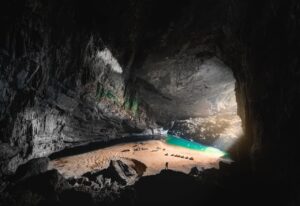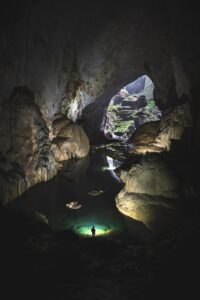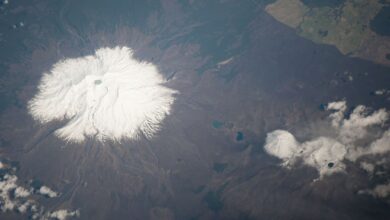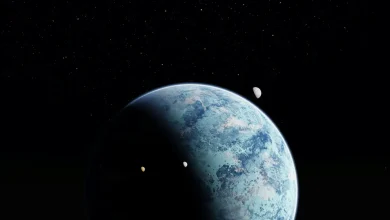The Worlds Largest Cave – Hang Son Doong
Hang Son Doong – The World’s Largest Cave System
Nestled deep within the Phong Nha-Ke Bang National Park in Vietnam lies an extraordinary marvel of nature called Hang Son Doong. This majestic cave, discovered only recently in 1990 and fully explored in 2009, is hailed as the world’s largest known cave system.
Its stunning beauty and immense dimensions have captivated explorers and visitors alike, attracting adventurers from every corner of the globe to witness its awe-inspiring wonders firsthand.
Overview of Hang Son Doong
Son Doong, discovered in 1990 by a Phong Nha jungle man named Ho Khanh, is the largest cave in Vietnam and is often believed to be the largest cave in the world as measured by volume.
The British -Vietnam Cave Expedition Team, directed by Howard Limbert, formally surveyed and measured Hang Son Doong in 2009. The Expedition group then declared it to be the biggest natural cave in the world, measuring in at a whopping 38.5 million m3.
Dr. Tony Waltham and other prominent karst geologists across the world later confirmed the accuracy of the observations. This group and National Geographic magazine both said in the same year that Son Doong Cave was the biggest known natural limestone cave in the world.
It was officially recognized as the biggest natural cave in the world in 2013 by the Guinness World Records Organisation.
Features of Hang Son Doong
Inside the world’s longest subterranean corridor is an equally astonishing ecology. The subterranean river carved out these mammoth caves and filled them with formations made by water trickling down from an above jungle. Additional cave-specific highlights include:
Hope and Vision Passage
One of the most extensive parts of Son Doong is located here, and it is possible to see the glow of Doline 1’s light source from its entrance.
Cave specialists have determined that this route is huge enough to accommodate a Boeing 747 jetliner and a building of 40 stories. In addition, this corridor is home to the world’s tallest stalagmite, which stands at a colossal 80 m in height.
Fossil passage
Doline 1 is a campground positioned just over a 40-meter-deep subterranean river. Fossilized corals from hundreds of millions of years ago line this opening. After a long day of hiking, guests may cool themselves in the 17–20 C subterranean lake located in this corridor.
Life preservers and torches are essential for obvious reasons. Among the many highlights of the Son Doong Expedition, swimming in the subterranean lake is highly recommended by guests.
Cave pearls
Dripping water from the cave’s roof deposits calcium carbonate in the cave’s gour pools, where it crystallizes to make pearls. From the size of a pea to that of a baseball, they are available in a wide range of dimensions.
Son Doong cave pearls are generated naturally within the gour pool and glow beautifully beneath the lights, especially after a rainstorm.
When exposed to air or sunshine, these so-called “cave pearls” quickly lose their luster and become colorless, losing any monetary worth they might have had to begin with.
Passchendaele Passage
Below the Vietnam Great Wall, at a depth of 600 meters, is a large lake. The lake’s water had long since evaporated, leaving just a muddy path hip-deep in places when the expedition crew arrived.
The expedition crew had to put up a lot of effort to traverse the 600 meters of muddy terrain. The crew opted to call this stretch of challenging terrain Passchendaele because it reminded them of the film Passchendaele, which is based on the World War I battle of the same name.
During the wetter months of the year, particularly after significant rainfall, the tunnel will fill with water, creating a large, stunning jade-green lake. Visitors to Passchendaele will often utilize rafts or boats to navigate the area when the lake is at its highest level.
Doline 1: Dinosaurs Ahead
Doline 1 (or skylight) is a large aperture in Son Doong’s cave that was created when the roof caved down. The subsurface river also ends here.
Large solar rays will enter on bright days (between 11 am and 1 pm), particularly during the winter months of January, February, and March. The orbit of the sun casts sunlight deep into the cave, making its vast chambers visible.
The subterranean river’s mist combines with the illumination from above to produce a stunning sight. This breathtaking scene from Son Doong Cave was recently featured as a Google Doodle. People have compared it to Avatar or stated it seems like being on another planet.
Doline 2: Edam’s Garden
Doline 2 is roughly 1 kilometer from Doline 1, and it features a cave forest 200 meters below the limestone rocks. When you exit Doline 1, you’ll discover a little trail that winds its way into the woods.
This Doline has a spacious entrance that lets in a lot of natural light, making it ideal for the ferns, begonias, and even small trees that line its passageway to flourish. The second campground, Doline 2, is located across this woodland and requires a 30-minute hike to access.
Vietnam’s Great Wall
After nearly ten days of exploring and surveying in April 2009, the expedition team approached a massive calcite flowstone that blocked all paths out. Without the proper equipment, they turned around and headed back.
After departing Hang Son Doong Cave, the expedition team declared Son Doong to be the biggest natural cave in the world based on their measurements.
They named it the Great Wall of Vietnam because of how magnificent it looked, but nobody understood what was hiding behind that massive stalagmite at the time.
Son Doong Cave: Home to Mysteries Yet to Be Revealed
Experts in caves finally mapped out Son Doong in 2010 after completing the Great Wall of Vietnam. There were still unknowns in this cave. Many enormous caverns in Son Doong in Vietnam were discovered, explored, and measured by Howard Limbert’s team during their explorations from 2010 to 2022.
Hang Va was initially discovered by Ho Khanh in 1992, but it wasn’t until 2012 that exploration and mapping revealed its proximity to the Son Doong exit (just approximately 50m away).
At around 4.5 kilometers from the entrance, cavers discovered that the underground river retreated into a flooded channel below Doline 1. They thought the river led to Thoong (Thung) Cave, about 600 meters distant.
Son Doong Cave and Its Importance
Son Doong Expedition was formally introduced by Oxalis in 2014, following a few trial excursions in August 2013. Oxalis Adventure has made consistent efforts to aid Phong Nha – Quang Binh and Vietnam as a whole in accordance with its guiding principles of safety, conservation, and community participation.
Many national and international organizations have verified that Hang Son Doong Cave is the biggest natural cave in the world. Because of its significance, the cave has helped put Quang Binh on the international tourism map.
Other trips and businesses in the area have flourished because of Son Doong. Many hotels and guesthouses cater to visitors, and many locals enjoy secure employment and high earnings as a result.
The Son Doong tour has directly employed 125 persons in Phong Nha and indirectly employed hundreds more in the areas of food provision, lodging, and transportation.
Conclusion
Hang Son Doong is a natural treasure of colossal proportions, showcasing the remarkable beauty and power of nature.
With its grandeur and stunning formations, this awe-inspiring cave leaves visitors enchanted and humbled by the magnificence hidden beneath the surface of our planet. Exploring Hang Son Doong is an unforgettable adventure that offers a glimpse into the mysteries and wonders still awaiting discovery in our world.




